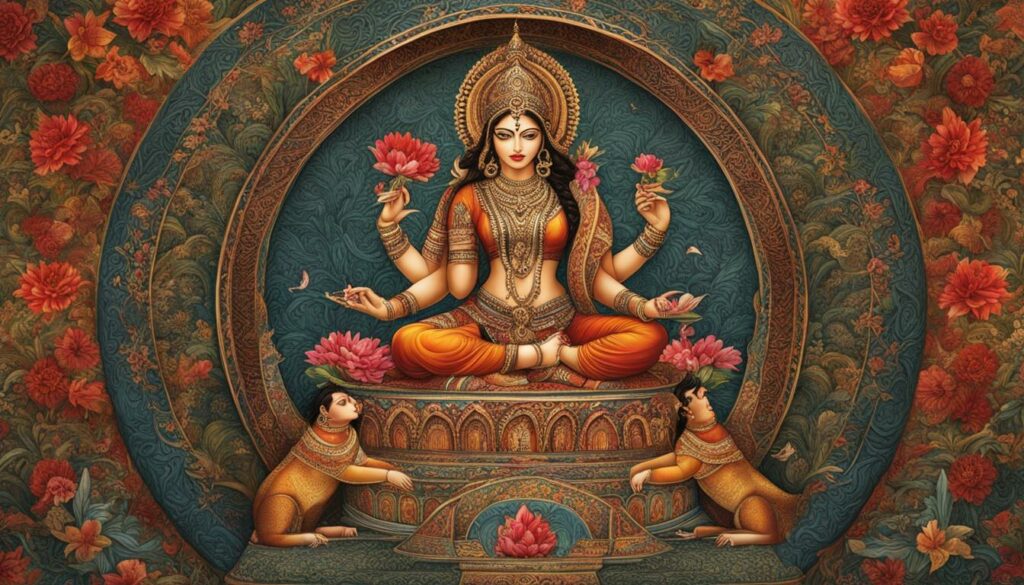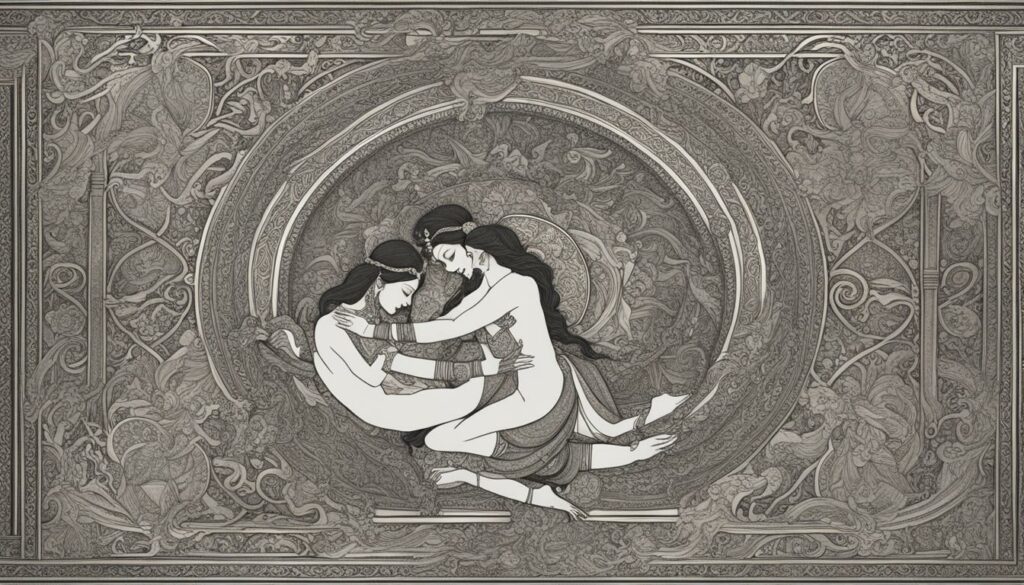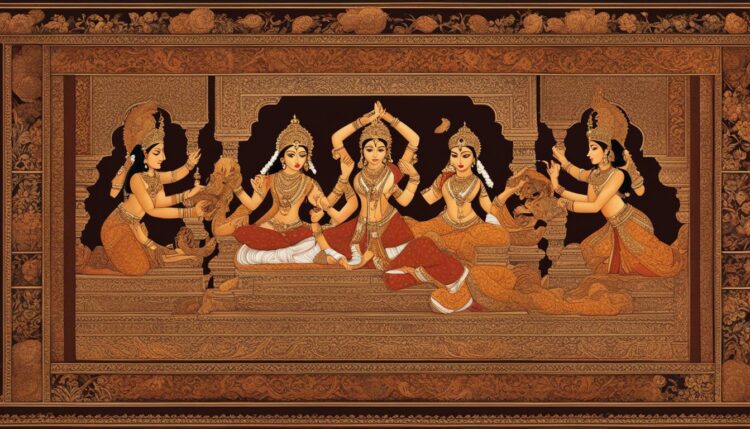Did you know that the Kama Sutra, the ancient erotic guide, goes far beyond sexual positions?
Contrary to popular belief, it is not just a manual for lovemaking techniques but a holistic approach to pleasure and desire. The Kama Sutra explores ancient Indian philosophies of sexual wellness, providing intimacy tips and guiding individuals and couples in establishing a spiritual connection in relationships.
Key Takeaways:
- The Kama Sutra offers a comprehensive guide to sexual wellness, emphasizing more than just sexual positions.
- It provides insights into the spiritual and emotional aspects of pleasure and desire in relationships.
- Ancient Indian philosophies of sexual wellness are intertwined with the teachings of the Kama Sutra.
- Communication, consent, and mutual pleasure are key principles emphasized in the text.
- Modern individuals and couples can benefit from the wisdom and guidance offered by the Kama Sutra to enhance their sexual experiences and deepen their connections.
The History and Origins of the Kama Sutra
The Kama Sutra, an ancient Hindu text written in Sanskrit by Vātsyāyana in the 3rd century CE, offers profound insights into love, intimacy, and relationships. With its 36 chapters, this renowned work goes beyond the commonly associated sexual positions and delves into the broader realm of love and intimacy in all aspects of life.
Initially, the Kama Sutra was not widely known in the Western world, until its translation into English by Sir Richard Francis Burton in the 19th century. This introduced the text to a global audience, highlighting its value as a seminal work on human sexuality and relationships.
“The Kama Sutra is not just a guide to sexual positions, but a comprehensive exploration of the complexities of love and intimacy.”
While the Kama Sutra may contain explicit content, it is important to recognize that it focuses on love, desire, and the spiritual connection inherent in relationships. It teaches individuals and couples to embrace pleasure, communicate effectively, and establish consent in order to promote a fulfilling and harmonious sexual experience.

Today, the Kama Sutra remains an important reference for those seeking to enhance their relationships and deepen their understanding of intimacy.
By studying this ancient text, individuals can explore the nuances of love and desire from a holistic perspective, incorporating both physical and emotional elements into their intimate connections.
As we continue our exploration of the Kama Sutra, we will delve further into the life and contributions of Vātsyāyana, the enigmatic author of this treasured text.
A Brief Biography of Vātsyāyana, the Author of the Kama Sutra
Vātsyāyana, the author of the Kama Sutra, was a Hindu philosopher and scholar who lived in India during the 3rd century CE. While not much is known about his life, it is believed that he wrote the Kama Sutra as an instructional guide for young men seeking knowledge of sexual pleasure.
Drawing on earlier texts, Vātsyāyana’s Kama Sutra stands as his most renowned contribution to Hindu literature.
The Kama Sutra not only goes beyond sexual positions but also delves into various subjects such as love, marriage, family life, personal grooming, etiquette, and social relationships. As a comprehensive guide, it offers insights into the multifaceted aspects of human connection.
“The Kama Sutra goes beyond mere physicality; it explores the intricate dynamics of love, desire, and relationships.”
Vātsyāyana’s work gained wider recognition in the 19th century when it was translated into English, introducing Western cultures to the ancient teachings of the Kama Sutra. This translation solidified its position as an important piece of literature, providing valuable insight into the ancient Indian culture and philosophy.
Contributions of Vātsyāyana’s Kama Sutra
| Contributions | Description |
|---|---|
| Comprehensive Guide | The Kama Sutra covers a wide range of topics, providing guidance on various aspects of love, relationships, and sexual pleasure. |
| Holistic Approach | Vātsyāyana’s teachings encompass not only physical intimacy but also emotional, mental, and spiritual connections, emphasizing a holistic approach to pleasure. |
| Insight into Ancient Indian Culture | The Kama Sutra offers a glimpse into the ancient Indian way of life, highlighting societal norms, customs, and values. |
| Enduring Influence | The Kama Sutra continues to be studied and cherished as a significant piece of literature, guiding individuals and couples in their quest for enhanced pleasure and deeper relationships. |
The Significance of the Kama Sutra in Indian Culture and Society
The Kama Sutra, despite not being widely accepted in traditional Indian society due to societal norms and taboos surrounding sex outside of marriage, holds great significance in Indian culture.
Rather than being viewed as a pornographic text, it is recognized as a didactic guide that offers valuable knowledge on love, relationships, and sexual pleasure.
Today, the Kama Sutra continues to be taught in universities and even integrated into sexual education classes, highlighting its importance in educating individuals about healthy sexual practices.
While its explicit content may be considered provocative by some, the text serves a larger purpose — it promotes mutual respect, consent, and communication in intimate relationships.
Furthermore, the Kama Sutra has left an indelible mark on Indian art and literature. Many paintings, sculptures, and poems, reflective of the rich history and cultural heritage of India, depict scenes inspired by the Kama Sutra.
These artistic expressions serve as a testament to the enduring influence of the text on various art forms throughout centuries.
“The Kama Sutra is not just about sexual positions; it is a celebration of love, pleasure, and human connection. It emphasizes the importance of embracing intimacy and understanding the needs and desires of one’s partner.”
By exploring the intricacies of love, desire, and human relationships, the Kama Sutra transcends its reputation as a mere erotic guide. It offers a deeper understanding of the complexities of love and intimacy in traditional Indian society and provides valuable lessons on enhancing pleasure and fostering emotional connections.
| Significance of the Kama Sutra | In Indian Culture and Society |
|---|---|
| Guidance on love, relationships, and sexual pleasure | Educational value in universities and sexual education |
| Impact on Indian art and literature | Inspiration for paintings, sculptures, and poems |
| Emphasis on mutual respect, consent, and communication | Understanding the complexities of love and intimacy |
The Kama Sutra, despite its controversial origins and explicit nature, continues to be revered as a valuable piece of Indian cultural heritage. Its teachings on sexual education, love, and relationships remain relevant in modern times, making it a cornerstone of Indian art, literature, and societal understanding.

Conclusion
The Kama Sutra, an ancient text known for its comprehensive guide to sexual positions and techniques, remains relevant in modern times. Beyond its reputation as a purely erotic manual, the Kama Sutra delves into the intricacies of communication, consent, and mutual pleasure in sexual relationships.
It provides valuable insights into the nature of love, desire, and human connections, making it a valuable resource for individuals and couples seeking to deepen their understanding of sexuality.
Contrary to popular misconceptions, the Kama Sutra covers a wide range of topics beyond sexual pleasure. It offers advice on marriage, courtship, and even how to enjoy various aspects of life.
This ancient text is rooted in ancient traditions and offers a holistic approach to pleasure and intimacy, encompassing spiritual and emotional connections in addition to physical gratification.
Approaching the Kama Sutra with an open mind is essential, as not all aspects may be suitable for everyone. However, by exploring the teachings that resonate with individual preferences and desires, individuals can enhance their sexual experiences and foster deeper connections in their relationships.
The Kama Sutra remains a testament to the enduring wisdom of ancient traditions, providing guidance and inspiration for modern explorations of pleasure and intimacy.
FAQ
What is the Kama Sutra?
The Kama Sutra is an ancient Indian Sanskrit text that goes beyond being a mere sex manual. It is a comprehensive guide to enriching intimacy, embracing holistic pleasure, and deepening connections in relationships.
What topics does the Kama Sutra explore?
The Kama Sutra explores various topics, including love, finding a life partner, maintaining love life, pleasure-oriented faculties of human life, courtship, training in the arts, sexual positions, and philosophy of love.
How has the Kama Sutra influenced Indian art and literature?
The Kama Sutra has left a significant impact on Indian art and literature, with depictions of Kama-related reliefs and sculptures in old Hindu temples.
Is the Kama Sutra still relevant in modern times?
Yes, the Kama Sutra is still relevant in modern times, emphasizing communication, consent, and mutual pleasure in sexual relationships, as well as providing guidance on sexual positions and techniques for individuals and couples looking to enhance their sexual experiences.
Who was the author of the Kama Sutra?
The author of the Kama Sutra was Vātsyāyana, a Hindu philosopher and scholar who lived in India around the 3rd century CE.
What other topics does the Kama Sutra cover besides sexual positions?
The Kama Sutra covers topics such as love, marriage, family life, personal grooming, etiquette, and social relationships.
Was the Kama Sutra widely accepted in traditional Indian society?
No, the Kama Sutra was not widely accepted in traditional Indian society, as sex outside of marriage was heavily frowned upon. However, it was seen as a didactic text that offered guidance on love, relationships, and sexual pleasure.
How does the Kama Sutra emphasize communication and consent in relationships?
The Kama Sutra emphasizes the importance of communication and consent, promoting open dialogue and understanding between partners to ensure mutual pleasure and fulfillment.
Is the Kama Sutra solely focused on eroticism?
No, the Kama Sutra covers a wide range of topics, including marriage advice, courtship tips, and overall ways to enjoy a fulfilling life.
How can the Kama Sutra enhance sexual experiences?
The Kama Sutra provides insights into various sexual positions and techniques, offering individuals and couples the opportunity to explore new ways of experiencing pleasure and deepening their connection.




